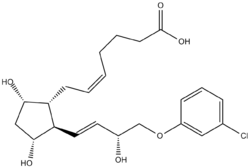Chemistry:Cloprostenol
From HandWiki
Short description: Chemical compound
 | |
| Clinical data | |
|---|---|
| Trade names | Cyclomate, Estrumate |
| Routes of administration | Intramuscular |
| ATCvet code | |
| Pharmacokinetic data | |
| Excretion | 67% renal, 25% fecal |
| Identifiers | |
| |
| CAS Number | |
| PubChem CID | |
| ChemSpider | |
| UNII | |
| Chemical and physical data | |
| Formula | C22H29ClO6 |
| Molar mass | 424.915 |
| 3D model (JSmol) | |
| |
| |
Cloprostenol is a synthetic analogue of prostaglandin F2α (PGF2α).[1] It is a potent luteolytic agent; this means that, within hours of administration, it causes the corpus luteum to stop production of progesterone, and to reduce in size over several days.[1] This effect is used in animals to induce estrus and to cause abortion.[2]
References
- ↑ 1.0 1.1 "Prostaglandins in veterinary practice". In Practice 3 (1): 30, 32-4. January 1981. doi:10.1136/inpract.3.1.30. PMID 7346485.
- ↑ "Cloprostenol Sodium". Plumb's Veterinary Drug Handbook (8th ed.). Wiley. 2015. ISBN 9781118911938.
 |

